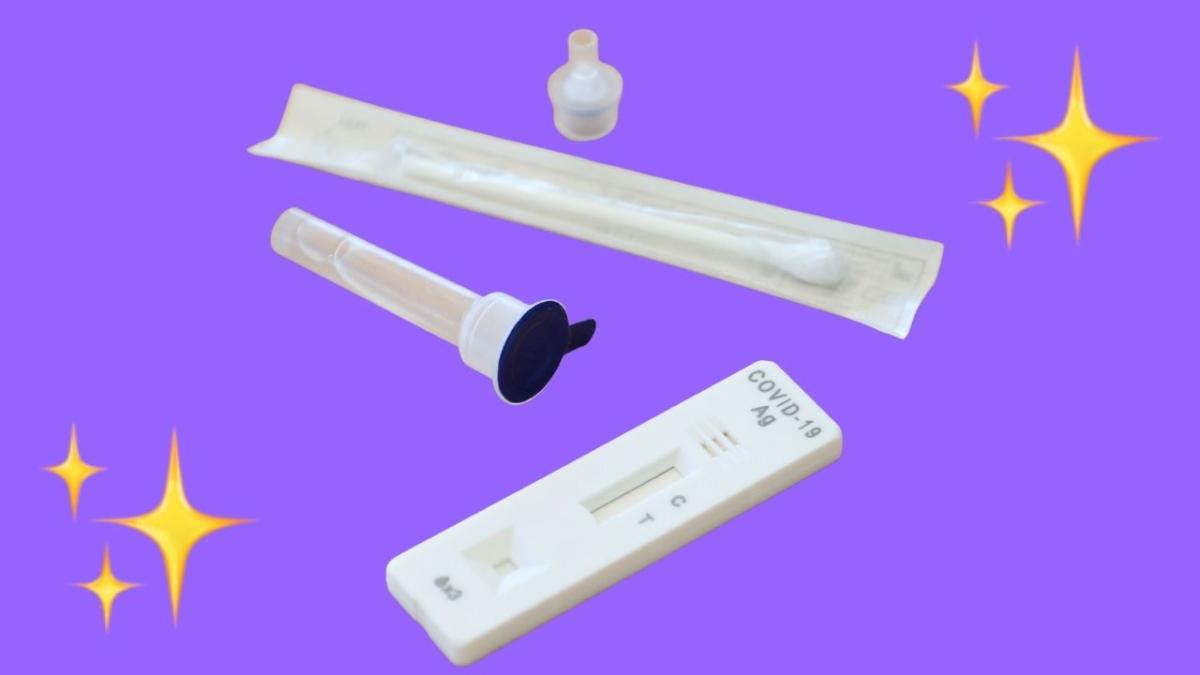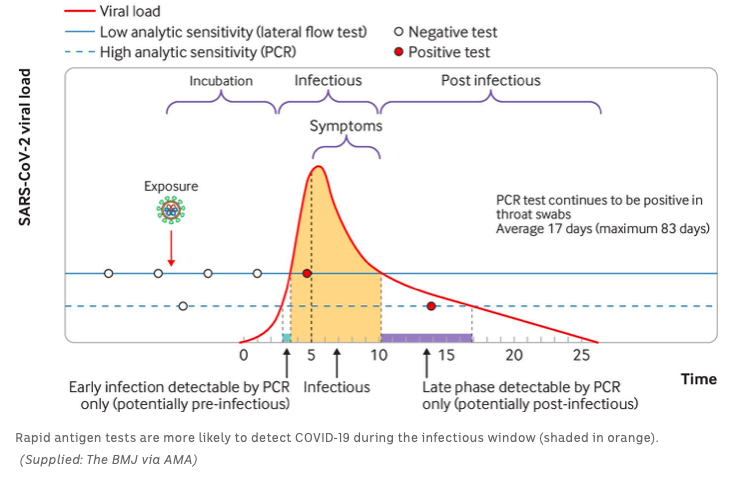
By now, I’m sure you are all acquainted with the humble RAT: rapid antigen tests that can be administered at home with results on your COVID status within 15 minutes.
Obviously, this is amazing — we’ve come a long way in testing for the virus, and a part of my heart is swelling with pride at the rapid way scientists have adjusted to COVID. BUT, there’s still a lot to be aware of (politically and otherwise) regarding rapid tests in Australia. So, let’s get into some of the questions surrounding these little miracles of science.
Can I eat or drink before taking a rapid antigen test?
No, at least if the rapid antigen test requires you to collect your saliva instead of a nasal swab.
The federal government’s Therapeutic Goods Association (TGA) updated its guidelines for taking a RAT at home on Wednesday, February 2nd. It said that you shouldn’t “eat, drink, smoke, brush your teeth or chew gum” for 10 to 30 minutes before taking a saliva-based rapid antigen test because it could give you an inaccurate result.
Are rapid antigen tests as accurate as PCR tests?
The short answer here is: no. The longer answer is still no, but in a more ‘there’s pros and cons to both‘ way.
Rapid tests are only about 77 per cent as accurate as PCR tests, according to one Australian study. They work best if someone has a high viral load, ie, they’ve been infected for several days and are feeling the symptoms, with accuracy best around five to seven days after infection.

This means that false positives are very unlikely on rapid tests if they’re used correctly, but false negatives are fairly common for asymptomatic people who’ve just picked up the virus.
Which rapid antigen test is considered the most accurate?
The TGA (Therapeutic Goods Administration) has recently approved a handful of Rapid Antigen Tests, sorting them into three different categories based on sensitivity compared to a PCR test.
A RAT test that has a sensitivity of 80% or higher is considered to have the minimum clinical sensitivity needed to be approved by the TGA, whereas tests with higher sensitivities are considered to be cream of the crop.
Here are the tests and the categories they fall under (over 80%, over 90% and over 95% effective) below:
“Very High Sensitivity” Over 95% sensitivity:
- All Test SARS-CoV-2 Antigen Rapid Test (Nasal Swab) (ICOV-502H) Self-Test – Nasal swab
- Cellife Covid-19 Antigen Test Cassette for self-testing – Nasal swab
- Clungene Covid-19 Antigen Rapid Test for self-testing – Nasal swab
- Flowflex SARS-CoV-2 Antigen Rapid Test (Self-Testing) – Nasal swab
- LYHER Novel Coronavirus (Covid-19) Antigen Test Kit (Colloidal Gold) Self-Test – Nasal swab
- OnSite COVID-19 Ag Self Test – Nasal swab
- Panbio COVID-19 Antigen Self-Test – Nasal swab
- Rapid SARS-COV-2 Antigen Test Card Self-test – Nasal swab
- V-Chek COVID-19 Antigen Saliva Test – Saliva
“High Sensitivity” Over 90% sensitivity:
- All Test COVID-19 Antigen Rapid Test (Oral Fluid) Self-Test (ICOV-802H) – Oral fluid
- Hough COVID-19 Home Test – Nasal swab
- JusChek SARS-CoV-2 Antigen Rapid Test (Nasal Swab) INCP-502H Self Test – Nasal swab
- JusChek COVID-19 Antigen Rapid Test (Oral Fluid) ICOV-802H Self Test – Oral fluid
- My Covid Test Antigen Rapid Test (Oral Fluid) (ICOV-802H) Self-Test – Oral fluid
- Orawell COVID-19 Ag Rapid saliva test device (Self-test) – Saliva
- RightSign COVID-19 Antigen Rapid Test Cassette (Nasal Swab) – Nasal swab
- TESTSEALABS COVID-19 Antigen Test Cassette – Nasal swab
“Acceptable Sensitivity” 80-90% sensitivity:
- CareStart COVID-19 Antigen Home Test – Nasal swab
- Ecotest COVID-19 Antigen Saliva Test kit (COV-S35Pen) – Saliva
- InnoScreen COVID-19 Antigen Rapid Test Device (Self Test) – Nasal swab
- SARS-CoV-2 Antigen Self Test Nasal – Nasal swab
So there you have it folks, happy swabbing!
When should I use a rapid test?
According to current close contact and isolation rules, you need to do a rapid antigen test if you are a close contact but you’re asymptomatic. If you’re a close contact and do have symptoms, you need to get a PCR test.
In terms of when is the best time to do a rapid test, Dr Chris Moy, vice president of The Australian Medical Association, warned that RATs are less reliable in the earlier and later ends of COVID infection. Scroll up and check out the graph above for a good rendition of how that works.
“What [rapid antigen tests are] very good at is picking up whether you’re in the infectious phase. That means the time you’re actually likely to be shedding the virus and actually spreading it to other people,” he said, per ABC.
“If it’s negative, you’re probably in the clear for at least the next few hours or … maybe the next few days,” he said.
So in that way, RATs are most effective five to seven days after you reckon you were exposed to COVID.
They’re best used as a regular precaution, like before going to large gathos, and you should use them every few days if you’re around vulnerable people. BUT, if you think you may have COVID and you’re definitely symptomatic, don’t just rely on a rapid test — get a PCR test if you can.
Are rapid antigen tests going to be free?
You’d think the government would make all COVID tests free considering this is a highly transmissible virus that does not discriminate, but Prime Minister Scott Morrison has declared (twice) that this won’t be the case.
“We are now at this stage of the pandemic we just cannot make everything free because when someone tells you they will make something free, someone will always pay for it, and it is going to be you,” he said on Sunrise on Monday.
Isn’t this the whole point of taxes? Collectively paying for essential things (like healthcare or education) so that everyone can have access to them??? RATs seem a preferable way to spend taxpayer money than, say, the $270 billion our government pledged to warfare in our last budget.
Remember when Scott Morrison criticised the Australian public for ‘panic buying.’ Yet somehow he’s okay with places like Harvey Norman, Kogan and Chemist Warehouse bulk buying rapid antigen tests and exploiting their customers by overpricing them.
— Kaleidoscope News (@kaleidoscope_au) January 2, 2022
Imagine allowing huge companies to keep millions of dollars of JobKeeper they weren’t entitled to, but then saying we can’t spend tax payer money on rapid tests. Capitalism is hell, and our PM is the devil.
Okay, well how much do I have to pay for them then?
Generally, retail price for rapid tests is around $50 for a pack of five, or $25 for a pack of two.
But of course, pharmacies, chemists and other retailers are exploiting the need for these tests and price gouging the fuck up. There’s been reports of places in Sydney selling individual tests (removed from their original packaging!!!) for $25 each. So, $100 for four. It’s messed up.
The NSW government has warned these companies not to exploit customers lest they face Fair Trade’s wrath, but so far that doesn’t seem to have stopped anyone.
Are they at least tax deductible?
Yes. It is the tiniest, most flimsy silver lining ever. So keep your receipts for those overpriced tests, okay.
What if I legally have to do a rapid test and can’t afford one?
The PM has confirmed that those who *have* to do a rapid test will be provided one.
“We already make them free to everyone who is required to have one,” he told Sunrise.
He also announced the government is working on some kind of concessional arrangement for pensioners.
“We understand the need for that and we will be doing that 50-50 with the states and territories,” he said.







